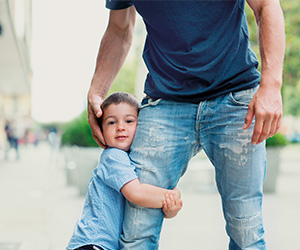‘Don’t talk to strangers’ is a mantra parents have drilled into youngsters for generations. But is this enough to protect our kids these days? Ciska Thurman finds out
 Imagine we could all live in the sanitised, innocent world of children’s books, where danger was easily identified: lurking in a dark corner, dressed in a black cloak or covered in wolf’s fur. Sadly, it is not that simple, and it’s a parent’s duty to untangle the stereotypes preserved in such tales and open their children’s eyes to the threats around them – especially the ones that appear harmless, kind and familiar.
Imagine we could all live in the sanitised, innocent world of children’s books, where danger was easily identified: lurking in a dark corner, dressed in a black cloak or covered in wolf’s fur. Sadly, it is not that simple, and it’s a parent’s duty to untangle the stereotypes preserved in such tales and open their children’s eyes to the threats around them – especially the ones that appear harmless, kind and familiar.
The different guises
‘Child abuse can be emotional (verbal), physical or sexual in nature,’ says Jacki Graham, the head teacher at Thabile Nursery School in Joburg. ‘The abuser could be a complete stranger, or someone the child knows very well, like a cousin, aunt
or family friend.’
Child abuse is defined as an action that is destructive to the child’s sense of security. It can occur in the child’s home, or in organisations and communities they interact with. It can also include neglect or excessive discipline by parents.
How do we keep them safe?
Start by introducing the concept of ‘stranger danger’ from the age of three, says Jacki. The signs of danger, and how to respond to them, can be extended to apply to anyone, from strangers and acquaintances to the young and the old.
Here are three easy steps to follow when introducing this to your child:
• Keep it simple Talk about how a stranger is someone we don’t know; therefore, we don’t know whether they are a good or bad person.
• Keep it real Use examples they can relate to: ‘Would you take a cupcake from a nice lady who speaks to you in the shops?’ or ‘Would you go home from school with a friendly man who says he works with dad?’
• Keep it reactive Encourage your child to discuss with you any strange interaction, invitation or advance, no matter how silly it may seem.
‘Don’t overload your child with information,’ says Jacki. Start with those three pointers and then give them a chance to ask questions
to satisfy their own understanding of ‘stranger danger’.
Use positive reinforcement when you see them responding the way you want them to (‘I’m so proud
of you for checking with me before inviting that lady and her children inside’). And remember to discuss different, everyday scenarios at regular intervals – so you continue emphasising that threats can be disguised in many different ways and often seem attractive.
Serve and protect
Most important is creating a safe space within which to talk about anything with your child. This will almost certainly prevent a poten-tially harmful situation developing or getting worse.
‘This is achieved from early on, by discussing emotions,’ advises Jacki. ‘Share the day’s range of emotions over supper (“I felt happy when daddy phoned to say hello” or “I felt sad because my friend is sick”), and encourage your kids to do the same.’ Diversify into more complex emotions: anger, fear, even anxiety. This normalises the emotions we all experience, and gives your child the vocabulary and confidence
to come to you for help.
Private property
Sexual abuse is a difficult subject
to raise with youngsters who are not yet sexually aware. Without going into too much detail (especially if you are still on the ‘not yet’ side of the sex talk), talk simply and clearly about body parts that are private: ‘This means that no one is allowed to touch you there.’ In fact, Jacki recommends using bathtime as
an opportunity to model respect for genitalia. Get into the habit of offering your little one the sponge and asking whether they’d like to wash themselves, or whether you can. It is important that they feel
a sense of ownership and control over their own bodies rather than shame. Urge them to come to you if ever faced with a sexual advance – secrets are destructive and they should know that they have done nothing wrong.
When it’s not a stranger
If your child reports abuse by someone you know, you must stay calm. Your reaction may dissuade them from further disclosure – these details will be important going forward.
Applaud them for showing the courage to tell you, and assure them you’ll take care of things. Cease contact with the offender and then take action. Notify the authorities; don’t try to handle the situa-
tion yourself. To avoid further confusion, anxiety and guilt, ensure your child does not hear discussions of the matter. Ensure you too seek support, but not where your child can hear or see you. The prognosis for healing in your child is far stronger if they feel supported and you remain composed.
Practical tips
• Agree on a code word with your children – something that only you and they will know means ‘this is safe’. If a situation should arise with a stranger that you know is safe (you’ve asked a friend to collect them from school in a crisis), tell the person to use the word.
• Ensure your children memorise the following telephone numbers: your cellphone number, your local police station/security company, 10111 (emergency response), 10177 (ambulance) and 0800 123 321 (child emergency).







